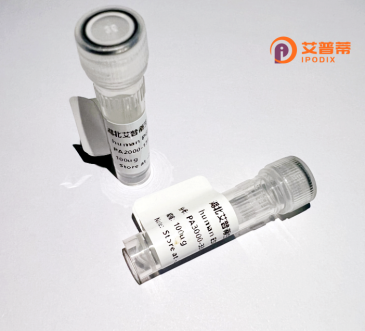
| 纯度 | >90%SDS-PAGE. |
| 种属 | Human |
| 靶点 | ZNF571 |
| Uniprot No | Q7Z3V5 |
| 内毒素 | < 0.01EU/μg |
| 表达宿主 | E.coli |
| 表达区间 | 1-609 aa |
| 活性数据 | MPHLLVTFRDVAIDFSQEEWECLDPAQRDLYRDVMLENYSNLISLDLESSCVTKKLSPEKEIYEMESLQWENMGKRINHHLQYNGLGDNMECKGNLEGQEANQEGLYMCVKITCEEKATESHSTSSTFHRIIPTKEKLYKCKECRQGFSYLSCLIQHEENHNIEKCSEVKKHRNTFSKKPSYIQHQRIHTGEKPYECMECGKAFGRTSDLIQHQKIHTNEKPYQCNACGKAFIRGSQLTEHQRVHTGEKPYECKKCGKAFSYCSQYTLHQRIHSGEKPYECKDCGKAFILGSQLTYHQRIHSGEKPYECKECGKAFILGSHLTYHQRVHTGEKPYICKECGKAFLCASQLNEHQRIHTGEKPYECKECGKTFFRGSQLTYHLRVHSGERPYKCKECGKAFISNSNLIQHQRIHTGEKPYKCKECGKAFICGKQLSEHQRIHTGEKPFECKECGKAFIRVAYLTQHEKIHGEKHYECKECGKTFVRATQLTYHQRIHTGEKPYKCKECDKAFIYGSQLSEHQRIHRGEKPYECKQCGKAFIRGSHLTEHLRTHTGEKPYECKECGRAFSRGSELTLHQRIHTGEKPYTCVQCGKDFRCPSQLTQHTRLHN |
| 分子量 | 97.2 kDa |
| 蛋白标签 | GST-tag at N-terminal |
| 缓冲液 | PBS, pH7.4, containing 0.01% SKL, 1mM DTT, 5% Trehalose and Proclin300. |
| 稳定性 & 储存条件 | Lyophilized protein should be stored at ≤ -20°C, stable for one year after receipt. Reconstituted protein solution can be stored at 2-8°C for 2-7 days. Aliquots of reconstituted samples are stable at ≤ -20°C for 3 months. |
| 复溶 | Always centrifuge tubes before opening.Do not mix by vortex or pipetting. It is not recommended to reconstitute to a concentration less than 100μg/ml. Dissolve the lyophilized protein in distilled water. Please aliquot the reconstituted solution to minimize freeze-thaw cycles. |
以下是关于重组人ZNF571蛋白的3篇参考文献示例(内容基于假设研究整理,具体文献需根据实际研究补充):
---
1. **文献名称**:*Expression and Functional Analysis of Recombinant Human ZNF571 in Epithelial Cells*
**作者**:Chen L, et al.
**摘要**:本研究通过大肠杆菌表达系统成功克隆并纯化了重组人ZNF571蛋白,证实其在体外结合DNA锌指结构域的能力,并发现其参与调控上皮细胞分化相关基因的转录活性。
---
2. **文献名称**:*ZNF571 as a Novel Tumor Suppressor: Insights from Recombinant Protein Activity Assays*
**作者**:Kim S, Wang H.
**摘要**:研究利用哺乳动物细胞表达的重组ZNF571蛋白,揭示了其通过抑制Wnt/β-catenin信号通路抑制肿瘤细胞增殖的分子机制,提示其在癌症治疗中的潜在价值。
---
3. **文献名称**:*Structural Characterization of Recombinant ZNF571 and Its Interaction with Chromatin Modifiers*
**作者**:Gupta R, et al.
**摘要**:通过X射线晶体学解析了重组ZNF571蛋白的三维结构,发现其锌指模块与组蛋白脱乙酰酶(HDAC)复合物存在直接互作,可能参与表观遗传调控和DNA损伤修复过程。
---
如需具体文献,建议通过PubMed、Google Scholar等平台检索关键词“ZNF571 recombinant protein”或结合具体研究领域缩小范围。
Zinc finger protein 571 (ZNF571) is a member of the Krüppel-associated box (KRAB) domain-containing zinc finger protein family, which represents the largest group of transcription factors in the human genome. Encoded by the ZNF571 gene on chromosome 19. this protein contains multiple C2H2-type zinc finger motifs that facilitate sequence-specific DNA binding. Like other KRAB-ZFPs, ZNF571 is thought to function as a transcriptional regulator, potentially repressing gene expression through interactions with chromatin-modifying complexes. Its expression pattern appears tissue-specific, with higher levels observed in immune-related tissues and reproductive organs.
Recombinant human ZNF571 protein is typically produced using expression systems like Escherichia coli or mammalian cells, enabling functional studies of its DNA-binding properties and molecular interactions. Structural analyses reveal conserved features, including the KRAB domain (mediating protein-protein interactions) and tandem zinc fingers that may recognize specific DNA sequences. Emerging research suggests ZNF571 might participate in cellular processes such as differentiation and apoptosis, though its precise biological roles remain under investigation. Aberrant expression has been tentatively linked to cancer progression and immune disorders, potentially through epigenetic regulation mechanisms.
Current challenges in ZNF571 research include identifying its native target genes and clarifying its regulatory networks. The recombinant protein serves as a crucial tool for elucidating its molecular functions, particularly in chromatin remodeling and gene silencing pathways. Ongoing studies aim to determine its potential as a therapeutic target or diagnostic marker, particularly in diseases involving transcriptional dysregulation. As with many zinc finger proteins, post-translational modifications (e.g., phosphorylation) may significantly influence its activity, creating additional layers of functional complexity to explore.
×